Original 1963 DISNEY THE SWORD IN THE STONE Cartoon CELL with DISNEYLAND Label
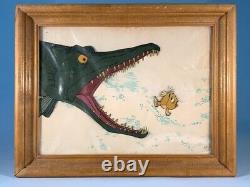



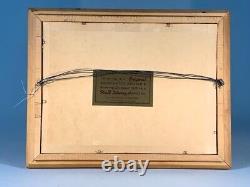
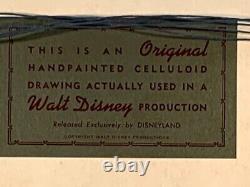
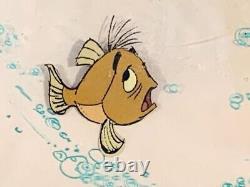
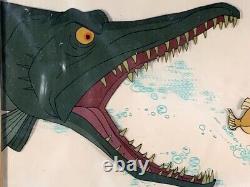
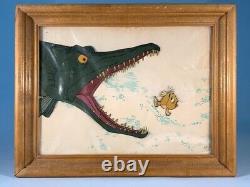



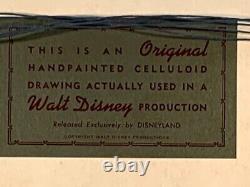
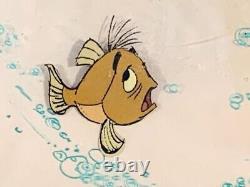
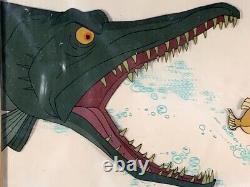

I WILL BE LISTING OTHER INTERESTING ANTIQUES THIS WEEK SO PLEASE CHECK MY OTHER AUCTIONS!! Cell is in its original mount with Disneyland sales label tag on the back.
No flaking to the image. This piece is beautifully framed and looks great, no visible damage noted but please review photos. Please look at the photos to get an idea of what this is. Photos accurately reflect the condition on this item.I may not be able to answer your questions immediately, but every question will be answered. Realistic reserve set just to protect my investment, if there is a reserve at all. Good luck and thanks for looking!!
The Sword in the Stone is a 1963 American animated musical fantasy comedy film produced by Walt Disney and released by Buena Vista Distribution. The 18th Disney animated feature film, it is based on the novel of the same name by T. White, first published in 1938 and then revised and republished in 1958 as the first book of White's Arthurian tetralogy The Once and Future King. Directed by Wolfgang Reitherman, the film features the voices of Rickie Sorensen, Karl Swenson, Junius Matthews, Sebastian Cabot, Norman Alden, and Martha Wentworth. It was the last animated film from Walt Disney Productions to be released in Walt Disney's lifetime. Disney first acquired the film rights to the novel in 1939, and there were various attempts at developing the film over the next two decades before production on the film officially began.Bill Peet wrote the story for the film, while the songs were written by the Sherman Brothers. This was the first animated Disney film to feature songs by the Sherman Brothers; they went on to contribute music to such Disney films as Mary Poppins (1964), The Jungle Book (1967), The Aristocats (1970), and The Many Adventures of Winnie the Pooh (1977).
George Bruns composed the film's score, following his work on the previous two animated Disney films, Sleeping Beauty (1959) and One Hundred and One Dalmatians (1961). He also composed the scores of the next three animated Disney films, The Jungle Book, The Aristocats, and Robin Hood (1973). The film received mixed reviews, but became a box-office success.
A live-action remake entered development in 2015 and is set to be directed by Juan Carlos Fresnadillo and released on Disney+. [3] Plot After the King of England, Uther Pendragon, dies without an heir to the throne, a sword magically appears inside an anvil atop a stone, with an inscription proclaiming that whoever removes it is the rightful King of England. Many have failed to remove the sword, which becomes forgotten, leaving England in the Dark Ages.
Years later, an 11-year-old orphan named Arthur, commonly called Wart, accidentally scares off a deer his older foster brother Sir Kay was hunting, causing Kay to launch his arrow into the forest. While retrieving the arrow, Arthur meets Merlin, an elderly wizard who lives with his talking pet owl Archimedes. Ector's friend, Sir Pellinore, arrives to announce that the winner of the upcoming New Year's Day tournament in London will be crowned king. Ector decides Kay will be a contender and appoints Arthur as Kay's squire. To educate Arthur, Merlin transforms them both into fish. They swim in the castle moat to learn about physics. After the lesson, Arthur is sent to the kitchen as punishment for attempting to relate what happened to Ector and Kay. Merlin enchants the dishes to wash themselves, then takes Arthur out again for another lesson. For the next lesson, Merlin transforms them both into squirrels to learn about gravity. Arthur almost gets eaten by a wolf, but is saved by a female squirrel who falls in love with him. After they return to human form, Ector accuses Merlin of using black magic on the dishes. Arthur defends Merlin, but Ector punishes Arthur by giving Kay another squire, Hobbs.Resolving to make amends, Merlin plans on educating Arthur full-time. However, Merlin's knowledge of future history confuses Arthur, prompting Merlin to appoint Archimedes as Arthur's teacher. Merlin transforms Arthur into a sparrow and Archimedes teaches him how to fly. Soon after, Arthur encounters Madam Mim, an eccentric, evil witch who is Merlin's nemesis.
Merlin arrives to rescue Arthur before Mim can destroy him, and Mim challenges Merlin to a wizards' duel and, despite Mim's cheating, Merlin outsmarts her by transforming into a germ and infecting her, illustrating the importance of knowledge over strength. On Christmas Eve, Kay is knighted. When Hobbs comes down with the mumps, Ector reinstates Arthur as Kay's squire. Merlin ultimately scolds Arthur for choosing war games over education. When Arthur attempts to justify his decision, Merlin angrily transports himself to 20th-century Bermuda. At the tournament, Arthur realizes he left Kay's sword at the inn. It is closed for the tournament, but Archimedes sees the "Sword in the Stone", which Arthur removes almost effortlessly, unknowingly fulfilling the prophecy. Ector places the sword back in its anvil, demanding Arthur prove that he pulled it. He pulls it once again, revealing that he is England's rightful king, earning Ector and Kay's respect and the former's apology.Later, the newly crowned King Arthur sits in the throne room with Archimedes, feeling unprepared for the responsibility of ruling a country. Voice cast Rickie Sorensen, Richard Reitherman, and Robert Reitherman as Arthur (aka Wart), the boy who will grow up to become the legendary British leader King Arthur. Sorensen entered puberty during the film's production, forcing director Wolfgang Reitherman to cast two of his sons, Richard and Robert, to replace him. [4][5] This resulted in Arthur's voice noticeably changing between scenes, and sometimes within the same scene.
The three voices also portray Arthur with an American accent, sharply contrasting with the English setting and the accents spoken by most of the other characters. " She notes even further that "Two [of the voice actors] were brothers, and sound somewhat similar; the third was not, and sounds distinctly different.
" Finally, she notes the issue of the American accents of the voices contrasting with the English setting and the accents spoken by most of the other characters in the film, noting, "The only positive: the vocal issues with Wart do help distract attention from the fact that the Brits aren't particularly good here, either. [6] Karl Swenson as Merlin, an old and eccentric wizard who aids and educates Arthur. Reitherman estimated that 70 actors read for the part, but none evidenced that note of eccentricity that we were seeking. We wanted Merlin to be eccentric, but not hokey.
Swenson initially read for Archimedes, but the filmmakers eventually decided to cast him as Merlin. [4] Junius Matthews as Archimedes, Merlin's crotchety, yet highly educated, pet owl and servant, who has the ability to speak. Sebastian Cabot as Sir Ector, Arthur's foster father and Kay's father.
Though he clearly cares for Arthur, he often treats him more like a servant than a son. Cabot also provides the narration at the beginning and end of the film. Norman Alden as Sir Kay, Arthur's morose and inept older foster brother and Ector's son. Unlike his father, he has much less regard for Arthur and thinks little good of him.
Martha Wentworth as Mad Madam Mim, a black-magic-proficient witch and Merlin's nemesis. Mim's magic uses trickery, as opposed to Merlin's scientific skill. Wentworth also voiced the Granny Squirrel, an elderly squirrel who is attracted to Merlin while Merlin is a squirrel. Alan Napier as Sir Pellinore, Ector's friend, who announces the jousting tournament. Thurl Ravenscroft as Sir Bart, one of the knights seen at the jousting tournament. James MacDonald as The Wolf, an unnamed, starving wolf that has several encounters with Arthur and attempts to eat him, but is constantly met with misfortune. Ginny Tyler as the Little Girl Squirrel, a young female squirrel that immediately develops an attraction to Arthur upon encountering him as a squirrel, in a scene in which the Girl Squirrel chases Arthur and tries to kiss him. Barbara Jo Allen as Scullery Maid, Ector's maid, who believes Merlin to be an evil sorcerer. Tudor Owen as the voice of one of the knights or nobles in the crowd during the tournament.White's The Sword in the Stone. [7] However, following the outbreak of World War II, the studio focused instead on producing cartoons for the United States government and armed forces such as Der Fuehrer's Face (1943). In June 1944, following the successful re-release of Snow White and the Seven Dwarfs (1937), Disney assigned writers to work on The Sword in the Stone, along with Cinderella (1950) and Alice in Wonderland (1951). [8] It continued to be announced that the project was in active development throughout the late 1940s and early 1950s. [9][10] In June 1960, Disney told the Los Angeles Times that, following the release of One Hundred and One Dalmatians, two animated projects were in development, which were Chanticleer and The Sword in the Stone.
[11] Around that same time, Disney's elder brother Roy O. Disney attempted to persuade him to discontinue their feature animation division, as enough films remained to make successful re-releases.The younger Disney refused, but, because of his plans to build another theme park in the United States, he would approve only one animated film to be released every four years. [12] Chanticleer was developed by Ken Anderson and Marc Davis, who aimed to produce a feature animated film in a more contemporary setting. They visited the Disney archives and decided to work on adapting the satirical tale after glancing at earlier conceptions dating back to the 1940s.
[13] Anderson, Davis, Milt Kahl, and director Wolfgang Reitherman spent months preparing elaborate storyboards for Chanticleer. Following a silent response to one pitch presentation, a voice from the back of the room said, You can't make a personality out of a chicken!
"[14] When the time came to approve either Chanticleer or The Sword in the Stone, Disney remarked that the problem with making a rooster a protagonist was, "[you] don't feel like picking a rooster up and petting it. [15] Meanwhile, The Sword in the Stone was developed solely by veteran story artist Bill Peet. After Disney had seen the 1960 Broadway production of Camelot, he approved the project to enter production. [16] Ollie Johnston stated, [Kahl] got furious with Bill for not pushing Chanticleer after all the work he had put in on it. He said,'I can draw a damn fine rooster, you know. Bill said,'So can I. "[17] Peet recalled "how humiliated they were to accept defeat and give in to The Sword in the Stone... He allowed them to have their own way, and they let him down.They never understood that I wasn't trying to compete with them, just trying to do what I wanted to work. I was [in] the midst of all this competition, and with Walt to please too. "[18] Writing in his autobiography, Peet said he decided to write a screenplay before producing storyboards, though he found the narrative "complicated, with the Arthurian legend woven into a mixture of other legends and myths" and that finding a direct storyline required "sifting and sorting. [19] After Disney received the first screenplay draft, he told Peet that it should have more substance. [19] The film continued the Xerox method of photocopying drawings onto animation cels that had been used in One Hundred and One Dalmatians (1961).
An additional animation technique, "touch-up", was created during production to replace the clean-up process. The clean-up process had required assistant animators to transfer the directing animators' sketches onto new sheets of paper, which were then copied onto the animation cels. To do a touch-up, the assistants would instead draw directly on the animators' sketches.This streamlined the process, but it also caused assistants of directing animator Milt Kahl to fear they would ruin his linework. [20] Release The Sword in the Stone premiered in London on December 12, 1963. It was released to theaters on December 18 in the United Kingdom and on December 25 in the United States.
It was re-released on December 22, 1972. The film was again re-released to theaters on March 25, 1983, as a double bill with the animated short Winnie the Pooh and a Day for Eeyore. This item is in the category "Entertainment Memorabilia\Movie Memorabilia\Props\Originals".
The seller is "bm75" and is located in this country: US. This item can be shipped worldwide.- Industry: Movies
- Personalize: No
- Movie Title: The Sword in the Stone
- Year: 1963
- Original/Reproduction: Original
- Country/Region of Manufacture: United States
- Production Company: Walt Disney Studios

